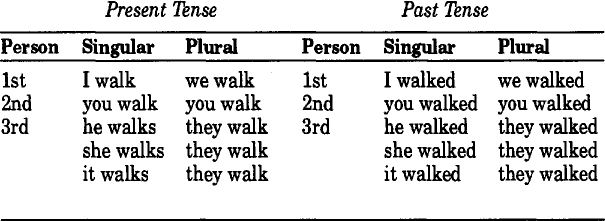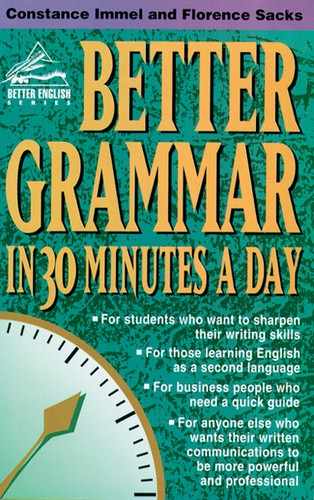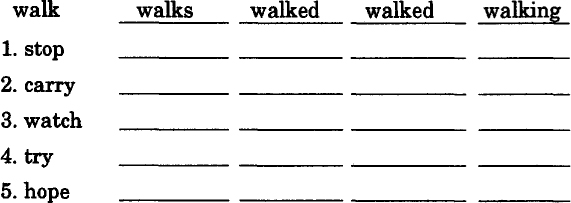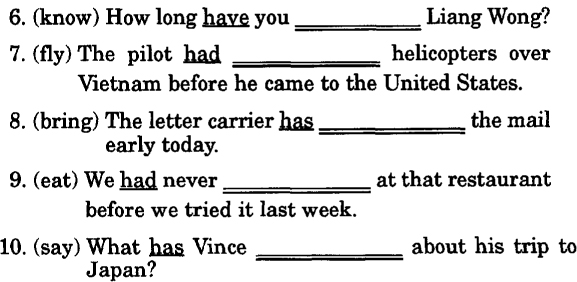Chapter 2
Verbs
2.1 Present and Past Tenses: Regular Verbs
Every sentence must have a verb to describe the action of the subject. Since the subject and the verb are the two most important parts of a sentence, learning to recognize verbs is essential to your progress in becoming a better writer. Let’s review three characteristics of verbs that help to identify them.
1. The verb tells what the subject does, did, or will do (action), is, was, or will be (linking).
Example: Reggie caught the fly ball.
What did Reggie do?
He caught. Therefore, caught is the verb.
2. The verb changes its form to show time (tense).
Example: Reggie catches the fly ball. (The time is the present.)
Reggie caught the fly ball. (The time is the past.)
Reggie will catch the fly ball. (The time is the future.)
3. The verb changes its form in the third person singular, present tense to agree with the subject.
Example: I catch the fly ball. (first person)
She/He catches the fly ball, (third person)
There are two kinds of verbs: action verbs and linking verbs.
Action Verbs
Most verbs tell what the subject (someone or something) does, did, or will do. These action verbs are usually easy to identify, especially when the action is a familiar one, such as swim, talk, buy, chew, study, or explode.
Linking Verbs
Other verbs show a relationship between the subject and a completer that follows the subject. The completer usually describes or renames the subject, and the linking verb links the subject to this completer.
Subject |
Linking Verb |
Completer |
Mr. Lopez |
is |
my Spanish teacher. |
He |
seems |
tired. |
Tacos |
taste |
good. |
The linking verb used most frequently is some form of the verb be (am, is are, was, were). Some other linking verbs are seem, grow, look, sound, taste, and appear.
Exercise 2.1
In the following sentences, underline the verbs and write them on the lines at the right.
1. The train stops for only a few moments at Oakhurst. |
____________ |
The train stopped for only a few moments at Oakhurst. |
____________ |
2. Gene hurries to get on the train already in motion. |
____________ |
Gene hurried to get on the train already in motion. |
____________ |
3. He trips over a woman’s suitcase in the aisle. |
____________ |
He tripped over a woman’s suitcase in the aisle. |
____________ |
4. Gene and the woman glare at each other. |
____________ |
Gene and the woman glared at each other. |
____________ |
5. In his seat at last, he watches the dawn through the smeary windows of the train. |
____________ |
In his seat at last, he watched the dawn through the smeary windows of the train. |
____________ |
The verbs in Exercise 2.1 form the past tense by adding -d or -ed to the base form. Most verbs follow this pattern. These are called regular verbs.
Verbs change their forms to indicate the time the action takes place. We call this sign of time tense. The present tense is used in commands and suggestions and to indicate habitual action or continuing ability.
Examples: Command: Deliver this message immediately.
Suggestion: Discourage them from coming if you can.
Habitual action: He paints beautifully.
Present progressive tense indicates that something is taking place right now and may continue to occur for a while. The words now and right now often indicate the use of the present progressive tense.
Examples: I am driving carefully.
He is chopping the onions now.
The past tense is used in sentences about action that happened before the present time. Say “Yesterday” at the beginning of the sentence to remind you to use the past tense.
Examples: Yesterday he chopped the onions for tonight’s dinner.
Here is a chart showing the pattern of the regular verbs in the present and the past tenses.
Model Verb-Walk

Exercise 2.2
Underline the verb in each of the following sentences. Write the present tense form of each verb on the line at the right.
1. Momoko planned a ski vacation in the mountains. |
____________ |
2. She worked extra hours at her job. |
____________ |
3. She saved half of her paycheck every week. |
____________ |
4. Momoko opened a special bank account. |
____________ |
5. She watched her money grow very slowly. |
____________ |
6. She waited for the first heavy snowfall. |
____________ |
7. She listened to the weather forecast every day. |
____________ |
8. Finally, the weather changed. |
____________ |
9. It snowed for three days and nights. |
____________ |
10. Momoko removed her money from the bank happily. |
____________ |
2.2 Present and Past Tenses: Irregular Verbs
Most verbs are regular verbs. We add -d or -ed to them to form the past tense. Verbs that do not add -d or -ed to form the past tense are called irregular verbs. Use your dictionary to find the past tense of irregular verbs or consult the chart of irregular verbs that follows.
Here is a chart listing some of the most commonly used irregular verbs.



Exercise 2.3
All of the verbs in the following sentences are present tense forms of irregular verbs. Underline each verb. Then write the past tense form of each verb on the line at the right.
Example: The convention begins on Thursday. |
began |
1. Jugglers meet once a year at an international convention. |
____________ |
2. They come from all age groups and many occupations. |
____________ |
3. Each one gives a demonstration of his or her specialty. |
____________ |
4. Everyone makes his or her presentation unique. |
____________ |
5. These artists throw just about everything from cigar boxes to gold lamb beanbags up in the air. |
____________ |
6. Some ride unicycles during their performances. |
____________ |
7. One man even eats parts of an apple and a cucumber in his act. |
____________ |
8. Jugglers have their names in the Guinness Book of World Records. |
____________ |
9. Rastelli, an Italian juggler, still holds the record: ten balls or eight plates in motion at once. |
____________ |
10. Amateur or professional, jugglers keep things on the move. |
____________ |
2.3 Principal Forms of Verbs
When you change the spelling of a verb, you are changing the form of the verb. All verbs have five principal forms.
1. The present or base form is the verb without any changes in spelling. It is used with the pronouns I, you, we, and they and with plural nouns.
Examples: walk see
2. The present +s form is spelled by adding an -s or -es to the base form. It is used with singular nouns and with the pronouns he, she, and it.
Examples: walks sees
3. The past form is spelled by adding -d or -ed to a regular verb. Irregular verbs change the base form spelling in different ways. They should be memorized. The past form is used with all pronouns and nouns.
Examples: walked saw
4. The past participle is spelled the same as the past form in regular verbs. Irregular verbs that change the spelling should be memorized. The past participle is used with a form of the auxiliary verb have.
Examples: has walked has seen
5. The present participle is spelled by adding -ing to the base form of the verb. It is used with a form of the auxiliary verb be.
Examples: am walking am seeing
All VERBS form the PRESENT PARTICIPLE by adding -ing to the PRESENT form:
![]()
Some verbs, however, require a spelling change:
A. Drop a final, unpronounced e before adding a suffix beginning with a vowel.
![]()
B. Double a final single consonant before a suffix beginning with a vowel: (1) if the consonant ends a stressed syllable or a word of one syllable, and (2) if the consonant is preceded by a single vowel.
![]()
Exercise 2.4
Add -ing to these words.
1. let ___________________
2. jump ___________________
3. hit ___________________
4. occur ___________________
5. drip ___________________
6. wrap ___________________
7. return ___________________
8. swim ___________________
9. scream ___________________
10. get ___________________
Exercise 2.5
Write the principal forms of the following regular verbs. Use your dictionary.

Example:
Principle Forms of Irregular Verbs
Unlike regular verbs, irregular verbs do not form their past and past participles by adding -d or -ed to the present form. Instead, they use some other change in form or they don’t change at all:
begin-began-begun go-went-gone set-set-set
Exercise 2.6
Write the principal forms of the following irregular verbs.

Example:
2.4 Auxiliary Verbs
An auxiliary verb is often added to the main verb to form the verb in a sentence. The present participle and the past participle forms are not used alone as the verb in a sentence. They are preceded by an auxiliary verb.
Example: Do not write: |
Thomas taking his brother to the park. |
Do write: |
Thomas is taking his brother to the park. |
Note: When the verb phrase is underlined in this book, one line will indicate the auxiliary verb and two lines, the main verb. Example: will be speaking
The auxiliary verb has two main uses. First, the auxiliary verb indicates shades of meaning that cannot be expressed by a main verb alone.
He might go to college. |
He can go to college. |
He should go to college. |
Would he go to college? |
Second, the auxiliary verb indicates tense—the time the action of the verb takes place.
He is going to college. |
He will go to college. |
He has gone to college. |
He does go to college. |
Note that in a question, the subject separates the auxiliary verb and the main verb.
Will he go to college?
Auxiliary verbs are commonly divided into two groups.
Group 1: The following words are used with main verbs, but they are not used as verbs alone except in answer to a question. They signal the approach of a main verb.
![]()
Exercise 2.7
Underline the auxiliary verb once and the main verb twice. There may be more than one auxiliary verb.
Example: I would like to place an order.
1. Do you shop at home?
2. You might have received a mail-order catalog from time to time.
3. Many people have found these catalogs convenient.
4. Years ago, farm families could send for clothes and household needs.
5. Today, urban shoppers can order a variety of goods from specialty stores.
Group 2: The following verbs may be used as auxiliary verbs or as main verbs. When they serve as auxiliaries, another form of a verb is used as the main verb of the verb phrase.

Remember
1. A sentence must always have a main verb, but it may or may not have an auxiliary verb.
2. If the sentence has an auxiliary verb, it is always placed in front of the main verb.
3. In a question, the subject separates the auxiliary verb and the main verb.
Exercise 2.8
In the following sentences, underline the auxiliary verb or verbs once and the main verb twice. Do not underline the contraction for not (n’t).
Example: I didn’t understand the question.
1. Many injured athletes have been helped by a new instrument called an arthroscope.
2. With the arthroscope, doctors can see inside the knee.
3. The doctor can examine bones and tissues.
4. The surgery may be done within an hour.
5. Without the arthroscope, a doctor must cut open the knee.
Summary
1. Present and past participles must be accompanied by an auxiliary verb.
2. Present and past participles cannot function alone as the verbs of a sentence.
3. Be, have, and do sometimes function as auxiliary verbs.
I have finished my homework. I didn’t speak to him.
I was eating.
4. Be, have, and do often function alone in a sentence as main verbs.
I have a penny. I do my homework. I was an only child.
Exercise 2.9
Fill in the correct form of the main verb in parentheses to complete the sentence. Consult the chart of irregular verbs or your dictionary.
Adverbs
An adverb is a modifier that adds further information about verbs, adjectives, and other adverbs. The following adverbs, in addition to others, frequently appear between auxiliary verbs and main verbs. These words are not auxiliary verbs. Do not underline them as verbs.

Examples: Television will never completely replace the radio.
The football game has just ended.
Contractions
In conversation and informal writing, two words are often joined together with an apostrophe that takes the place of any missing letters. The contraction for not (n’t) may be added to many auxiliaries, for example:
![]()
Note: n’t is not an auxiliary verb; do not underline it as one.
Examples: We hadn’t seen them for years.
The mechanic couldn’t repair the car in one day.
Exercise 2.10
In the following sentences, underline the auxiliary verb or verbs once and the main verb twice. Put parentheses around any adverbs or contractions.
Example: Cassandra does(n’t) smoke cigarettes any longer.
1. Dr. Dimaio isn’t in her office today.
2. You should always practice your scales.
3. My boss must certainly give me a raise.
4. Tim may travel to New Orleans next month.
5. Could you close the window for me?
2.5 Future Tense
The future tense is used for sentences about something that will happen in the future. The future tense is formed by using the auxiliary verbs will or would and the base form of the main verb. Here is a chart showing the pattern of all verbs in the future tense.
Model Verb—Walk
Although it is correct to express future action by using the present progressive tense (I am going to graduate in June.), use only the future tense (I will graduate in June.) when you are writing the exercises in this lesson.
Exercise 2.11
Complete the following sentences by using the future tense of the verb in the parentheses.
Will and Would
Will points to the future from the present. |
know/will |
Would points to the future from the past. |
knew/would |
a. You know that you will do well in this class.
In sentence a, “you know” now (in the present) that “you will do well” in the future.
b. You knew that you would do well in this class.
In sentence b, “you knew” then (in the past) that “you would do well” in the future.
Exercise 2.12
In the following sentences, fill in will or would to indicate the future.
1. Herb knows that he ______________ win someday.
2. Herb knew that he ______________ win someday.
3. Wu arrives early so he ______________ get the best seats.
4. Wu arrived early so he ______________ get the best seats.
5. He says that he ______________ hire a band.
6. He said that he ______________ hire a band.
2.6 Perfect Tenses
In the lesson on auxiliary verbs, you used the perfect tenses in some of the verbs that you identified or wrote. The name perfect tenses gives no clue to the uses of these tenses. Study the following examples to learn how to use the perfect tenses.
A. The present perfect tense is formed by using the auxiliary verb have in the present tense plus the past participle of the main verb.
Model Verb—Run

Use the present perfect tense to show that an action began in the past and has continued until now, or that an action has just happened. It is often used to show that an action occurred at an indefinite time in the past. Adverbs such as just and already are commonly included.
Exercise 2.13
Fill in the present perfect tense of the verb given in the parentheses. Use the chart of irregular verbs or your dictionary.
Example: Mike has seen all the home games of the Dallas Cowboys this season.
B. The past perfect tense is formed by using the auxiliary verb had plus the past participle of the main verb.
Model Verb—Run

Use the past perfect tense to show that one action happened before another action in the past. Use it only when you are writing in the past tense.
Exercise 2.14
Fill in the past perfect tense of the verb given in parentheses. Use the chart of irregular verbs or your dictionary.
Example: After we had seen the play, we went to a restaurant for dessert.
C. The future perfect tense is formed by using the auxiliary verbs will have plus the past participle of the main verb.
Model Verb—Run

Use the future perfect tense to show that something will happen in the future by a specific time.
Exercise 2.15
Fill in the future perfect tense of the verb given in parentheses. Use the chart of irregular verbs or your dictionary.
Example: By the time her trip is over, Anita will have seen every state in the United States.
1. (learn) By this time next week, you _________ _________ how to drive a car.
2. (pay) By this time next year, Paul _________ _________ for the car.
3. (live) By next June they _________ _________ in that house for twenty years.
4. (go) By September I _________ _________ to college for two years.
5. (speak) By election day the candidate _________ _________ at ninety meetings.
2.7 Tense Shift Problems
Do not shift tenses in the middle of a sentence, a paragraph, or an essay unless you have a reason to do so. If you begin writing in the present tense, don’t shift to the past. If you begin in the past, don’t shift to the present.
Incorrect: |
Kite flying is a good way to meet people. They were curious when they saw my kite up there. They wonder why I waste my time with a kite. |
Shifts from present to past tense and back to present tense. |
Correct: |
Kite flying is a good way to meet people. They are curious when they see my kite up there. They wonder why I waste my time with a kite. |
All the verbs are in the present tense. |
Correct: |
Kite flying was a good way to meet people. They were curious when they saw my kite up there. They wondered why I wasted my time with a kite. |
All the verbs are in the past tense. |
Exercise 2.16
Some of the following sentences contain shifts in tense. Identify each error by drawing a line under the incorrect verb. Write the correct form above the word.
![]()
1. Last Tuesday night I went to the library because I had a test in history on Wednesday morning. It is too noisy at home to study. My brother is playing the stereo, my mother was vacuuming, and my little sister and her friend are chasing each other around the house. How am I supposed to concentrate with all that commotion?
2. My friend Greg loves peanut butter. Every morning he spread peanut butter on his toast or waffles. He snacked on peanut butter cups at school, and, of course, he ate peanut butter sandwiches for lunch every day. Nowadays he bakes his own peanut butter cookies because his mother had refused to make them anymore. Greg was a hopeless case; he even covers a slice of chocolate cake with peanut butter.
3. My wife and I bought a golden retriever puppy last year. We made the mistake on the first few nights of allowing the puppy to sleep on a rug by our bed because he misses his brothers and sisters. Later when we made a bed for him in the laundry room, he howls and scratches on the door for several hours every night. After a while the neighbors call on the telephone to complain about the noise. We thought that he will never give up. The puppy finally learned to sleep by himself, and the neighbors start speaking to us again.









